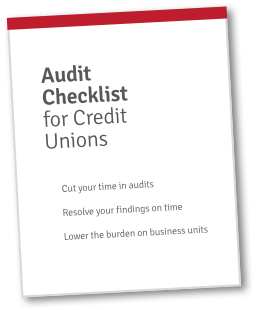Credit union audits and exams are ongoing compliance activities for auditors and business units alike. Yet, without a solid, repeatable structure, they can drain significant time and resources. And in today’s economy, resources are already at their breaking point.
Credit unions that value growth and efficiency must focus their resources on growth and other strategic initiatives. Consequently, they must reduce time spent on audits without sacrificing performance.
Three credit unions of different sizes weighed in about their strategies.
Introducing the Credit Unions
Recently, Redboard and CU 2.0 hosted a webinar where three credit unions shared their strategies for satisfying compliance needs despite limited resources. We were joined by:
- Steve Pagenstecher, COO of Point West Credit Union. Point West controls around $100m in assets and discussed the difficulties posed by version control in spreadsheets and email.
- Aaron Hibbard, VP Risk and Compliance at Spectra Credit Union (formerly NRL FCU). Spectra is a $500m credit union and mentioned time management issues when trying to handle compliance, risk, vendor management, and audits.
- Jill Holak, Internal Audit Manager at Digital Credit Union (DCU). DCU has just under $10b in assets and over 1,600 employees—that number of employees posed a challenge to coordinating between departments and adequately tracking findings.
Scroll down to read their insights, or simply watch the video below to hear from them firsthand.
Improving Communication
Emails work great for general communication, but they fall short for audits. Audit communication works best when it’s centralized so that everyone (in all business departments) are on the same page as the auditor(s).
So, whether sending a document, requesting a response, or checking in about deadlines, credit unions must centralize audit files and communications.
Without centralized communications, the panel noted that things slip through the cracks. Follow-up emails would get no response for days. If missed communications put credit unions in position for tight deadlines, that doesn’t set up environments conducive to best possible outcomes.
Digital Efficiency
The panel mentioned several benefits to keeping audit activity digital. Switching from physical to digital (and even automated) audit workpapers helped credit unions like DCU continue a robust audit process while working remotely and in different locations.
And, building off of the last point (centralizing communications), keeping audits digital allows for more time savings through better file management. Centralizing documents—and especially using a digital platform for audits—helps to keep file names and locations consistent. Not only will your internal team appreciate it, but so will external auditors or NCUA examiners.
Buy-In and Alignment
It’s paramount to ensure that all participants in the audit process are on board with any process, delivery, or platform changes. In addition to auditors, your credit union needs buy-in from:
- Business units
- External auditors or examiners
- The supervisory committee
Redboard helps credit unions bring structure, clarity, and consistency to all audit activity. It ensures that everything happens on time and as expected. Credit unions that have used Redboard report that their business units love it, their examiners were impressed, and their supervisory committee appreciates the easy reporting.
We’re sure that if you introduce better structure, communication, and digital efficiency into your credit union’s audits, you’ll see similar benefits.
Next Steps for Credit Union Auditors and Executives
To take things to the next level, we have a few free resources for you and your audit team. These resources have helped auditors virtually eliminate overdue and unresolved findings while cutting audit administration time by 50%.


 Get FREE Access to the Audit Checklist for Credit Unions!
Get FREE Access to the Audit Checklist for Credit Unions!


